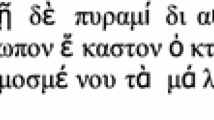Abstract
This paper presents an interactive graphics system called L.E.G.O. The purpose of L.E.G.O. is to model two- and three-dimensional objects using Euclidean geometry constructions. L.E.G.O. has a layered structure which makes it convenient to use, both for the experienced programmer and the novice. The programs may be written in a compiled language (C), written interactively in an interpreted language (LISP) or developed using a graphical interface in a multiple-window environment. Applications of L.E.G.O. include computer-assisted instruction of geometry and computer graphics, geometric modeling, and kinematic analysis. The use of imperative constructions and the powerful interface based on the idea of graphical programming are the most distinctive features of the system.
Similar content being viewed by others
References
Abelson H, diSessa A (1980) Turtle geometry: the computer as a medium for exploring mathematics. MIT Press, Cambridge
Behnke H, Bachmann F, Fladt K, Kunle H (eds) (1983) Fundamentals of Mathematics, vol. 2. Geometry. MIT Press, Cambridge
Bier A, Stone M (1986) Snap-dragging. Comput Graph 20(4):233–240
Borning A (1981) The programming language aspects of Thinglab, a constraint-oriented simulation laboratory. ACM Trans Program Lang Syst 3(4):353–387
Borning A, Duisberg R (1986) Constraint-based tools for building user interfaces. ACM Trans Graph 5(4):345–374
Coxeter HSM, Greitzer SL (1967) Geometry revisited, Random House, New York
Cundy HM, Rollet AP (1961) Mathematical models. Oxford Univ Press, London
Foderaro J (1979) The Franz LISP manual. Univ California, Berkeley
Foley JD, Van Dam A (1982) Fundamentals of interactive computer graphics. Addison-Wesley, Reading
Fuller N (1985) User's Guide to L.E.G.O. — Version 1.0. Tech Rep CS-85-19, Dep Comput Sci, Univ Regina
Fuller N, Prusinkiewicz P (1986) L.E.G.O. — An interactive graphics system for teaching geometry and computer graphics. Proc CIPS Edmonton '86 pp 75–84
Fuller N, Prusinkiewicz P (1988) Geometric modeling with Euclidean constructions. In: Magnenat-Thalmann N, Thalmann D (eds) New trends in computer graphics. Proc CG International '88, Springer, Berlin Heidelberg New York, pp 379–392
Fuller N, Prusinkiewicz P, Rambally G (1985) L.E.G.O. — An interactive computer graphics system for teaching geometry. Proc 4th World Conf Comput Educat, pp 359–364
Glinert EP, Tanimoto SL (1984) Pict: An interactive graphical programming environment. Computer 17(11):7–25
Hain K (1967) Applied kinematics. McGraw-Hill, New York
Knuth DE (1979) TEX and METAFONT. Digital Press and American Mathematical Society, Bedford
Lodding KN (1983) Iconic interfacing. IEEE Comput Graph Appl 3(2):11–20
Mandelbrot BB (1982) The fractal geometry of nature. WH Freeman, San Francisco
Nelsen G (1985) Juno, a constraint-based graphics system. Comput Graph 19(33):235–243
Noma T, Kunii TL, Kin N, Enomoto H, Aso E, Yamamoto T (1988) Drawing input through geometrical constructions: specification and applications. In: Magnenat-Thalmann N, Thalmann D (eds) New Trends in Computer Graphics. Proc CG International '88, Springer, Berlin Heidelberg New York, pp 403–415
Papert S (1980) Mindstroms: children, computers, and powerful ideas. Basic Books, New York
Pong MC, Ng N (1983) PIGS — A system for programming with interactive graphical support. Software Pract Exper 13(9):847–855
Prusinkiewicz P, Streibel D (1986) Constraint-based modeling of three-dimensional shapes. Proc Graph Interface '86 —Vision Interface '86, pp 158–163
Sutherland IE (1963) Sketchpad: a man-machine graphical communication system. In: 1963 Spring Joint Comput Conf. Reprinted in: Freeman H (ed) Interactive Computer Graphics. IEEE Comput Soc 1980, pp 1–19
Todhunter I (ed) (1933) Elements of Euclid. JM Dent & Sons, London
User's Guide for IRIS Graphics Programming (Version 3.0) (1986) Silicon Graphics, Mountain View, California
Van Wyk CJ (1982) A high-level language for specifying pictures. ACM Trans Graph 1(2):163–182
Wilensky R (1984) LISP craft, WW Norton, New York
Author information
Authors and Affiliations
Rights and permissions
About this article
Cite this article
Fuller, N., Prusinkiewicz, P. Applications of Euclidean constructions to computer graphics. The Visual Computer 5, 53–67 (1989). https://doi.org/10.1007/BF01901481
Issue Date:
DOI: https://doi.org/10.1007/BF01901481




